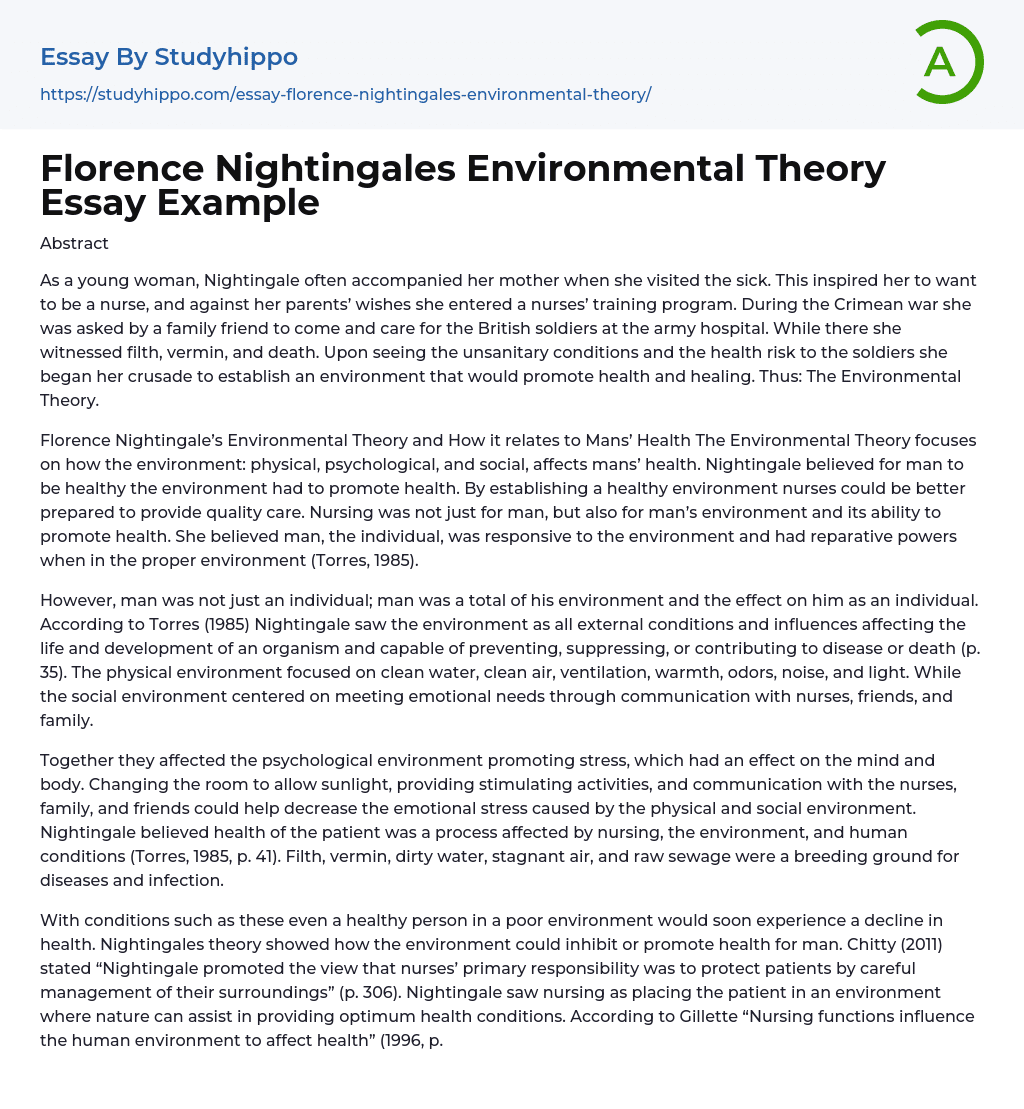Abstract
As a young woman, Nightingale often accompanied her mother when she visited the sick. This inspired her to want to be a nurse, and against her parents’ wishes she entered a nurses’ training program. During the Crimean war she was asked by a family friend to come and care for the British soldiers at the army hospital. While there she witnessed filth, vermin, and death. Upon seeing the unsanitary conditions and the health risk to the soldiers she began her crusade to establish an environment that would promote health and healing. Thus: The Environmental Theory.
Florence Nightingale’s Environmental Theory and How it relates to Mans’ Health The Environmental Theory focuses on how the environment: physical, psychological, and social, affects mans’ health. Nightingale believed for man to be healthy the environment had to promote health. By establishing a healthy environme
...nt nurses could be better prepared to provide quality care. Nursing was not just for man, but also for man’s environment and its ability to promote health. She believed man, the individual, was responsive to the environment and had reparative powers when in the proper environment (Torres, 1985).
However, man was not just an individual; man was a total of his environment and the effect on him as an individual. According to Torres (1985) Nightingale saw the environment as all external conditions and influences affecting the life and development of an organism and capable of preventing, suppressing, or contributing to disease or death (p. 35). The physical environment focused on clean water, clean air, ventilation, warmth, odors, noise, and light. While the social environment centered on meeting emotional needs through communication with nurses, friends, and family.
Together they affected the
psychological environment promoting stress, which had an effect on the mind and body. Changing the room to allow sunlight, providing stimulating activities, and communication with the nurses, family, and friends could help decrease the emotional stress caused by the physical and social environment. Nightingale believed health of the patient was a process affected by nursing, the environment, and human conditions (Torres, 1985, p. 41). Filth, vermin, dirty water, stagnant air, and raw sewage were a breeding ground for diseases and infection.
With conditions such as these even a healthy person in a poor environment would soon experience a decline in health. Nightingales theory showed how the environment could inhibit or promote health for man. Chitty (2011) stated “Nightingale promoted the view that nurses’ primary responsibility was to protect patients by careful management of their surroundings” (p. 306). Nightingale saw nursing as placing the patient in an environment where nature can assist in providing optimum health conditions. According to Gillette “Nursing functions influence the human environment to affect health” (1996, p. 64). While Nightingale understood the importance of medicine she emphasized the importance of environment on health. Nursing was not just for the patient but the environment and its relationship to the patient. Nursing has made much advancement since Nightingale Environmental Theory but the focus on a healthy environment has remained the same. Pulliam (1997) noted in her article that Nightingales’ theory formed a solid foundation for nursing: fresh air, cleanliness, clean water, warmth, proper drainage, plenty of light, and stress free environment provided an optimum environment for healing.
Nightingales’ theory has impacted my practice in many ways. As a circulating nurse I provide information about the procedure
and what to expect, this help decrease the patients’ anxiety related to their hospitalization. Also, patients get warm blankets when they enter the operating room; the temperature is monitored during the procedure, and the staff is monitored for breaks in sterile technique to help prevent postoperative infections.
Her theory has made me aware of the importance of “environment” in relations to the patients’ health.
References
- Chitty,K. K. , & Black, B. P. (2011) Professional nursing Concepts & challenges (6th ed) Maryland Height, MO: Saunders Gillette,V. (1996).
- Applying nursing theory to perioperative nursing practice. AORN Journal, 64(2), 261-269. Torres, G. (1985).
- Florence Nightingale. In J. B. George (Ed. ), The Base for Professional Nursing Practice (pp. 34-49). Englewoods Cliffs, NJ: Prentice-Hall.
- Anatomy and Physiology essays
- Addiction essays
- Biodegradation essays
- Dental Care essays
- Disease essays
- Disorders essays
- Health Care essays
- Intelligence Quotient essays
- Nutrition essays
- Olfaction essays
- Public Health essays
- Women's Health essays
- World health organization essays
- Cancer essays
- Infectious Disease essays
- Lung Cancer essays
- Neurology essays
- Physical Exercise essays
- Medicine essays
- Sex essays
- Inquiry essays
- Disability essays
- Poison essays
- Action Potential essays
- Nervous System essays
- Childbirth essays
- Puberty essays
- Blood essays
- Kidney essays
- Neuron essays
- Body essays
- Glucose essays
- Sense essays
- Heart essays
- Skeleton essays
- Human Physiology essays
- Eye essays
- Immune System essays
- Muscle essays
- Skin essays
- Brain essays
- Central Nervous System essays
- Human Skin Color essays
- Digestive System essays
- Common sense essays
- Respiration essays
- alcoholism essays
- Smoking essays
- Casino essays
- Tobacco essays




